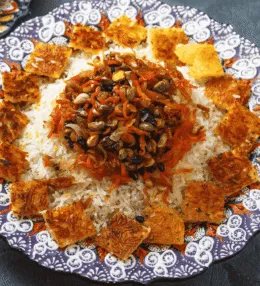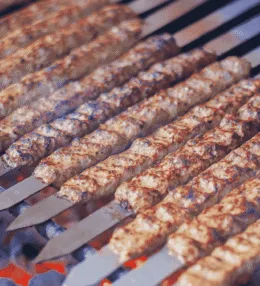
- View
Ask any Iranian about their favourite dish and Ghormeh Sabzi will likely emerge as a strong contender. This isn’t just food; it’s a conversation starter, a family heirloom recipe, and a measure of a cook’s skill all rolled into one fragrant pot.
The name itself tells you something important. “Ghormeh” refers to a braise or stew, whilst “Sabzi” means herbs. Yet these simple words barely scratch the surface of what makes this dish so beloved across Iran and throughout the Persian diaspora worldwide.
Every Iranian household has their own version, passed down through generations with small tweaks and personal touches. Some families swear by dried limes, others prefer fresh. The ratio of herbs sparks friendly debates, and the choice of meat can vary by region.
What remains constant is the dish’s ability to fill a home with an aroma so distinctive that anyone familiar with Persian cooking can identify it instantly. The scent of frying herbs mingles with slow cooked meat and tangy dried limes, creating something utterly unique.
What Is Ghormeh Sabzi?
Ghormeh Sabzi is a herb based stew that combines meat, kidney beans, and an abundance of fresh herbs with the sharp, citrusy punch of dried Persian limes. It’s traditionally served over fluffy basmati rice, preferably with a golden tahdig crust on the bottom.
The dish belongs to the khoresh family of Persian stews, but it stands apart for its unusual approach to herbs. Rather than using them as mere garnish or flavouring, Ghormeh Sabzi treats herbs as the primary ingredient, using them in quantities that might surprise cooks from other traditions.
The preparation requires patience and attention. Fresh herbs must be carefully washed, dried, and chopped. They’re then fried in oil until they darken and release their essential oils, transforming from bright green to a deep, almost blackish green colour.
This frying process is crucial and can take up to an hour. Rush it, and you’ll miss the depth of flavour that defines authentic Ghormeh Sabzi. The herbs need time to lose their raw edge and develop a complex, slightly bitter, intensely aromatic quality.
The stew simmers slowly, allowing the meat to become tender and the flavours to meld together. Dried limes, pierced to release their sour essence, infuse the liquid with a distinctive tartness that balances the richness of the meat and the earthiness of the herbs.
Ingredients and Taste
The herb mixture typically includes parsley, coriander, and fenugreek leaves in generous amounts. Fenugreek, called “shanbalileh” in Farsi, provides a slightly bitter note that’s essential to authentic flavour. Some recipes include spring onions or chives for additional depth.
Lamb or beef works equally well, cut into chunks that will become meltingly tender after hours of slow cooking. Kidney beans add substance and a creamy texture that complements the meat beautifully whilst soaking up the herby, tangy broth.
Dried Persian limes, known as “limoo omani,” are perhaps the ingredient that defines this dish beyond all others. These sun dried limes have a complex flavour that’s simultaneously sour, slightly sweet, and faintly smoky, unlike anything fresh citrus can provide.
Turmeric adds warmth and a golden undertone to the dark stew. Oil, typically vegetable or sunflower, is needed in reasonable quantity for properly frying the herbs. Salt and pepper round out the seasoning, though the dish needs little else given the intensity of its primary ingredients.
The taste is difficult to describe to those who’ve never experienced it. Imagine intensely herbal flavours, not fresh and bright but deep and concentrated. The sourness from the dried limes cuts through everything, creating a bracing contrast to the rich meat.
There’s a slight bitterness from the fenugreek and the darkened herbs that adds complexity rather than unpleasantness. The kidney beans provide textural relief and a mild, earthy sweetness. Everything comes together in a way that’s simultaneously comforting and exciting.
When served over rice, each spoonful delivers layers of flavour that unfold gradually. The dish tastes even better the next day, after the flavours have had more time to marry together in the refrigerator overnight.
A Taste of History
Ghormeh Sabzi’s origins reach back centuries into Persian culinary history. Stews have long formed the backbone of Iranian cooking, with recipes evolving through various dynasties and regional influences across the vast Persian empire.
The use of abundant fresh herbs reflects Iran’s agricultural traditions and the importance of gardens in Persian culture. The concept of the paradise garden, with its emphasis on plants and greenery, extends naturally into the kitchen where herbs aren’t just seasoning but central ingredients.
Dried limes likely entered Persian cooking through trade routes connecting Iran with southern regions where citrus grew abundantly. Arab traders introduced these preserved limes, which proved ideal for a land where fresh citrus wasn’t always available year-round.
The dish gained its current form sometime during the Qajar dynasty in the 19th century, though variations certainly existed earlier. As Iran modernised, Ghormeh Sabzi remained a constant, a link to tradition that transcended social class and regional differences.
Iranian families living abroad often cite Ghormeh Sabzi as the dish they crave when feeling homesick. It represents more than sustenance; it embodies memories of family gatherings, Friday lunches, and the comfort of home cooking.
The dish has also become a point of cultural pride. Iranians take great pleasure in introducing friends from other cultures to Ghormeh Sabzi, knowing its unusual flavour profile will either convert them into enthusiasts or leave them bewildered.
How to Make Ghormeh Sabzi (Herb and Kidney Bean Stew)
Ghormeh Sabzi is a beloved Iranian stew celebrated for its deep, earthy aroma and rich green hue. The blend of herbs, dried limes, and tender lamb creates a comforting balance of savoury and tangy flavours. The process is slow and rewarding, filling your kitchen with the unmistakable scent of Persian home cooking. See the recipe card at the bottom for printable directions
Ingredients
- 500 g lamb shoulder or leg, cut into small cubes
- 1 large onion, finely chopped
- 2 tbsp vegetable oil
- 250 g fresh spinach, chopped
- 150 g fresh parsley, chopped
- 80 g fresh coriander, chopped
- 50 g chives or spring onions, finely chopped (green parts only)
- 50 g dried fenugreek leaves (or 2 tbsp dried fenugreek powder)
- 1 cup dried red kidney beans, soaked overnight and drained
- 3 dried Persian limes (limoo amani), pierced with a fork
- ½ tsp turmeric powder
- ½ tsp black pepper
- 1 tsp salt, or to taste
- 4 cups water or light stock
- Cooked Persian rice (chelow), for serving
Cooking Instructions
Step 1: Prepare the herbs
Begin by finely chopping all the fresh herbs and spinach. Use a sharp knife to avoid bruising. Heat 1 tablespoon of oil in a large pan over medium heat and sauté the chopped herbs for 10–12 minutes until fragrant and dark green. Stir constantly to prevent burning. Set aside once done.
Step 2: Brown the meat
In a heavy based pot, heat the remaining oil. Add the chopped onion and cook until golden. Add turmeric, stirring for a few seconds to release its aroma, then add the lamb cubes. Brown the meat on all sides for a richer stew base.
Step 3: Combine herbs and beans
Add the sautéed herbs and soaked kidney beans to the pot. Stir everything together so the meat and herbs are evenly coated. This is where the flavours begin to merge beautifully.
Step 4: Add water and dried limes
Pour in 4 cups of water (or enough to just cover the mixture). Pierce the dried limes with a fork to let their tangy essence infuse the stew. Drop them into the pot and gently stir.
Step 5: Simmer slowly
Bring the pot to a gentle boil, then reduce the heat to low. Cover and simmer for about 1 hour, stirring occasionally. The slow simmering allows the herbs to mellow and the flavours to develop fully.
Step 6: Adjust seasoning
After an hour, check the liquid level. Add more hot water if it has thickened too much. Season with salt and black pepper, tasting to balance the earthy and citrus notes.
Step 7: Continue cooking
Simmer for another 45–60 minutes, until the meat is tender and the beans are soft. The oil should rise slightly to the surface, a sign that the stew has reached the right depth of flavour.
Step 8: Check the dried limes
Remove the dried limes if they have broken apart too much, as they can make the stew bitter. Alternatively, mash them gently against the pot’s side to release more flavour, depending on preference.
Step 9: Rest before serving
Once cooked, remove from heat and let the stew sit for 10–15 minutes. This short resting period allows the flavours to settle and deepen before serving.
Step 10: Serve with rice
Ladle the Ghormeh Sabzi into bowls and serve with steamed Persian chelow rice. Garnish with a few sprigs of fresh parsley or coriander for a touch of brightness.
Variations and Substitutions
- Meat options: Beef can replace lamb, though lamb gives the most traditional flavour.
- Beans: Black eyed peas or pinto beans can stand in for kidney beans if needed.
- Fenugreek substitute: Mix equal parts dried celery leaves and a touch of mustard seed for a mild alternative.
- Dried lime substitute: Use a small splash of lime juice and a strip of lemon peel if dried limes are unavailable.
Cooking Tips for Perfect Ghormeh Sabzi
- Sautéing the herbs properly is key to the stew’s authentic taste; undercooked herbs make it taste grassy.
- Always pierce dried limes before adding them to release their flavour evenly.
- Avoid over stirring once the beans start to soften to prevent them from breaking apart.
- Letting the stew rest before serving enhances its depth and richness.
- Serve with fluffy Persian rice to absorb the bold flavours beautifully.
How to Store and Reheat
Storage Methods
Ghormeh Sabzi stores exceptionally well, and many cooks insist it improves after a day or two in the refrigerator. Allow the stew to cool completely before transferring it to an airtight container to prevent condensation.
The stew will keep for up to four days in the refrigerator. The oil may solidify on top, forming a protective layer that helps preserve the dish. Simply stir it back in when reheating for the best consistency.
For longer storage, Ghormeh Sabzi freezes beautifully for up to three months. Portion it into freezer safe containers, leaving some headspace for expansion. Label clearly with the date, as frozen stews can look remarkably similar to one another.
Reheating for Best Results
Stovetop reheating works best for Ghormeh Sabzi. Transfer the stew to a pot and warm it gently over medium to low heat, stirring occasionally. Add a splash of water if the stew has thickened too much during storage.
Avoid high heat, which can break down the meat fibres further and make them stringy. Gentle, patient reheating preserves the texture whilst allowing the flavours to bloom again as the stew warms through completely.
Microwave reheating is acceptable for individual portions. Use a microwave safe bowl, cover it loosely, and heat in two-minute intervals, stirring between each round. Add a tablespoon of water to prevent drying out during the reheating process.
Serving Temperature Tips
Ghormeh Sabzi should be served hot but not scalding. Extreme heat can mask the subtle interplay of flavours, whilst serving it too cool makes the oil congeal unpleasantly. Aim for a temperature where steam rises gently from the surface.
If you’ve frozen the stew, thaw it overnight in the refrigerator rather than at room temperature for food safety. Then reheat using either the stovetop or microwave method described above for the best possible results.

Ghormeh Sabzi (Herb and Kidney Bean Stew)
Ingredients
- 500 g lamb shoulder or leg cut into small cubes
- 1 large onion finely chopped
- 2 tbsp vegetable oil
- 250 g fresh spinach chopped
- 150 g fresh parsley chopped
- 80 g fresh coriander chopped
- 50 g chives or spring onions finely chopped (green parts only)
- 50 g dried fenugreek leaves or 2 tbsp dried fenugreek powder
- 1 cup dried red kidney beans soaked overnight and drained
- 3 dried Persian limes limoo amani, pierced with a fork
- ½ tsp turmeric powder
- ½ tsp black pepper
- 1 tsp salt or to taste
- 4 cups water or light stock
- Cooked Persian rice chelow, for serving
Instructions
- Begin by finely chopping all the fresh herbs and spinach. Use a sharp knife to avoid bruising. Heat 1 tablespoon of oil in a large pan over medium heat and sauté the chopped herbs for 10–12 minutes until fragrant and dark green. Stir constantly to prevent burning. Set aside once done.
- In a heavy based pot, heat the remaining oil. Add the chopped onion and cook until golden. Add turmeric, stirring for a few seconds to release its aroma, then add the lamb cubes. Brown the meat on all sides for a richer stew base.
- Add the sautéed herbs and soaked kidney beans to the pot. Stir everything together so the meat and herbs are evenly coated. This is where the flavours begin to merge beautifully.
- Pour in 4 cups of water (or enough to just cover the mixture). Pierce the dried limes with a fork to let their tangy essence infuse the stew. Drop them into the pot and gently stir.
- Bring the pot to a gentle boil, then reduce the heat to low. Cover and simmer for about 1 hour, stirring occasionally. The slow simmering allows the herbs to mellow and the flavours to develop fully.
- After an hour, check the liquid level. Add more hot water if it has thickened too much. Season with salt and black pepper, tasting to balance the earthy and citrus notes.
- Simmer for another 45–60 minutes, until the meat is tender and the beans are soft. The oil should rise slightly to the surface, a sign that the stew has reached the right depth of flavour.
- Remove the dried limes if they have broken apart too much, as they can make the stew bitter. Alternatively, mash them gently against the pot’s side to release more flavour, depending on preference.
- Once cooked, remove from heat and let the stew sit for 10–15 minutes. This short resting period allows the flavours to settle and deepen before serving.
- Ladle the Ghormeh Sabzi into bowls and serve with steamed Persian chelow rice. Garnish with a few sprigs of fresh parsley or coriander for a touch of brightness.
Nutrition
You May Also Like







Leave a Review